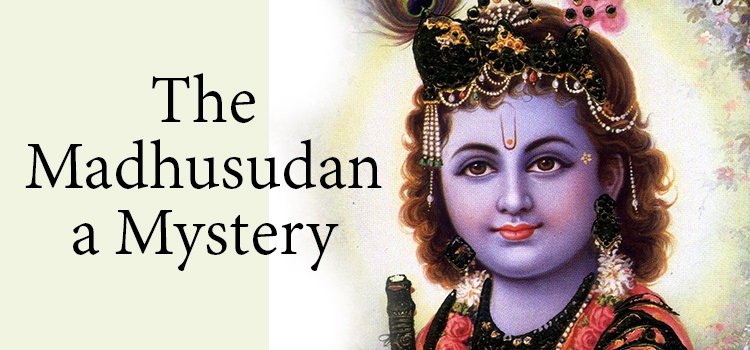The Madhusudana Mystery
In the Bhagavad-gita, a sacred text, Lord Krishna is called Madhusudana (the killer of the Madhu demon) five times. But Krishna never killed a demon called Madhu. Several commentators, like Srila Prabhupada, explain that by referring in this manner to Krishna, Arjuna indicates poetically that Krishna should kill Arjuna’s doubts, just as He had killed the demon. But when did this slaying happen?
Baladeva Vidyabhushana, an 18th century Vaishnava commentator, writes that Madhusudana implies that Krishna can slay Arjuna’s grief, the way he had killed Madhu in the past. Arjuna seems to have a specific reason for using this name.
Madhu, in fact, was not killed by Krishna but by Lord Vishnu. Krishna, as everyone knows, is an avatar of Vishnu. Vishnu took his Hayagriva incarnation to kill Madhu. So by calling Krishna ‘Madhusudana’, the Gita points to the connection between Krishna and Vishnu and hints at the former’s divinity.

Join in our 3-Priest Madhusudhana Homa for Relief from Sins and Suffering
Significance of the Name Madhusudana
The name Madhusudana appears initially in the First Chapter before Krishna tells Arjuna that both of them had been through many births and before he reveals his divine nature to Arjuna conclusively. Arjuna’s illusion is only a transcendental pastime, orchestrated by Krishna. Meaning, he is made to enter a temporary state of forgetfulness so that Krishna can instruct Arjuna through the Gita and through Arjuna, each one of us. Otherwise, how can Arjuna know that Krishna is none other than Vishnu, who had incarnated earlier to kill Madhu?
Prabhupada writes in the introduction to his commentary on the Gita that Arjuna, as Krishna’s associate, was above all ignorance, but he was put into ignorance on the Kurukshetra battlefield only to question Krishna about the problems of life so that Krishna could explain them for the benefit of human beings.
In the Mahabharata, Lord Shiva, too, had mentioned Arjuna’s divine partnership with Narayana, and Yama, the Lord of death, told Arjuna that he would lighten earth’s burden with Vishnu. All this happens before the Sixth Book, in which the Gita appears. Krishna also revealed his divine form to the people assembled in the Kaurava court when he was on his peace mission for the Pandavas. Thus, the main combatants knew all about Krishna’s divinity. Arjuna surely knew it, but he knew it not—like Yashoda, who, despite seeing the entire universe in infant Krishna’s mouth, still considered him to be her own son.
The name, Madhusudana, often comes up in the Mahabharata before the Gita, usually uttered by Vaishampayana, who was the narrator. But Arjuna, Draupadi, and the demon Sishupala also use the name as well. So, Krishna’s identity as Vishnu was evident early on in the Mahabharata and the Gita.
The Story of Madhu
The story of the demon Madhu is mentioned in the Kalika Purana, the Devi Bhagavata, and the Mahabharata.
Around the beginning of time, the spiritual world created the material universe, within which Lord Vishnu was reclining in deep cosmic slumber on Sesh Nag, his serpent bed. As Vishnu slept, a lotus stem emerged from his navel. On top of the stem was a lotus flower, on which Brahma, the first created being, appeared. Vishnu put him in charge of creation, and he meditated on how to accomplish his task.
As Brahma sat in meditation, ear wax came out of Vishnu’s ears. Two fierce demons, Madhu and Kaitabha, were born from that wax. They did rigorous penance for thousands of years. Pleased by their penance, Goddess Lakshmi, the Lord’s consort, appeared before them and granted them a boon whereby they would die only when they wanted. Soon, the demons became very arrogant. They attacked Brahma, who was still meditating on his lotus stem, and stole the four Vedas from him. Brahma was helpless as his adversaries were very powerful. He rushed to Vishnu, asking for help.
Vishnu, however, was in deep slumber and did not wake up, despite Brahma’s attempts to awaken Him. Realizing that the Lord had his own reasons to sleep, Brahma prayed to Yoga-Nidra, who is Goddess Lakshmi in a special form, to help the Lord attain yogic sleep. She took pity on him and awakened the Lord.
Brahma told Vishnu about the evil deeds of Madhu and Kaitabha and requested him to destroy them. Vishnu then took the form of Hayagriva, the beautiful horse incarnation, battled Madhu and Katabha, and retrieved the Vedic scriptures. But as per the boon, they could die only when they wanted. Vishnu cleverly told them that they should give him a boon, just as Goddess Lakshmi had given them a boon. He told them that they were very powerful, and so they should show him the same courtesy that Lakshmi, his feminine half, and the embodied form of His mystic energy, had shown towards them.
Being arrogant, they didn’t understand his ruse. When they asked what boon he wanted, he replied that he wanted their death. Thus, Vishnu, as Hayagriva, put an end to their nuisance. But Krishna was also an incarnation of Vishnu, so he came to be called Madhusudana, the slayer of the demon Madhu.
Vedic scriptures say that Madhusudana Vishnu Homam must be performed by people who have been enduring various problems in life and are seeking freedom from fear and destruction of enemies. It is also very helpful for getting relief from the sins of one’s past life and attaining salvation.



















